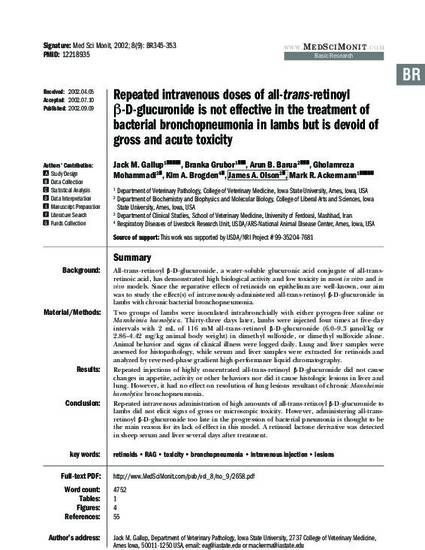
Article
Repeated intravenous doses of all-trans-retinoyl β-D-glucuronide is not effective in the treatment of bacterial bronchopneumonia in lambs but is devoid of gross and acute toxicity
Medical Science Monitor
Document Type
Article
Disciplines
Publication Date
1-1-2002
Abstract
BackgroundAll-trans-retinoyl β-D-glucuronide, a water-soluble glucuronic acid conjugate of all-transretinoic acid, has demonstrated high biological activity and low toxicity in most in vitro and in vivo models. Since the reparative effects of retinoids on epithelium are well-known, our aim was to study the effect(s) of intravenously-administered all-trans-retinoyl β-D-glucuronide in lambs with chronic bacterial bronchopneumonia.
Material/MethodsTwo groups of lambs were inoculated intrabronchially with either pyrogen-free saline or Mannheimia haemolytica. Thirty-three days later, lambs were injected four times at five-day intervals with 2 mL of 116 mM all-trans-retinoyl β-D-glucuronide (6.0–9.3 µmol/kg or 2.86–4.42 mg/kg animal body weight) in dimethyl sulfoxide, or dimethyl sulfoxide alone. Animal behavior and signs of clinical illness were logged daily. Lung and liver samples were assessed for histopathology, while serum and liver samples were extracted for retinoids and analyzed by reversed-phase gradient high-performance liquid chromatography.
ResultsRepeated injections of highly concentrated all-trans-retinoyl β-D-glucuronide did not cause changes in appetite, activity or other behaviors nor did it cause histologic lesions in liver and lung. However, it had no effect on resolution of lung lesions resultant of chronic Mannheimia haemolytica bronchopneumonia.
ConclusionRepeated intravenous administration of high amounts of all-trans-retinoyl β-D-glucuronide to lambs did not elicit signs of gross or microscopic toxicity. However, administering all-transretinoyl β-D-glucuronide too late in the progression of bacterial pneumonia is thought to be the main reason for its lack of effect in this model. A retinoid lactone derivative was detected in sheep serum and liver several days after treatment.
Rights
Works produced by employees of the U.S. Government as part of their official duties are not copyrighted within the U.S. The content of this document is not copyrighted.
Language
en
File Format
application/pdf
Citation Information
Jack M. Gallup, Branka Grubor, Arun B. Barua, Gholamreza Mohammadi, et al.. "Repeated intravenous doses of all-trans-retinoyl β-D-glucuronide is not effective in the treatment of bacterial bronchopneumonia in lambs but is devoid of gross and acute toxicity" Medical Science Monitor Vol. 8 Iss. 9 (2002) p. 345 - 353 Available at: http://works.bepress.com/jack_gallup/33/

This article is from Medical Science Monitor 8, no. 9 (2002): 345–353.